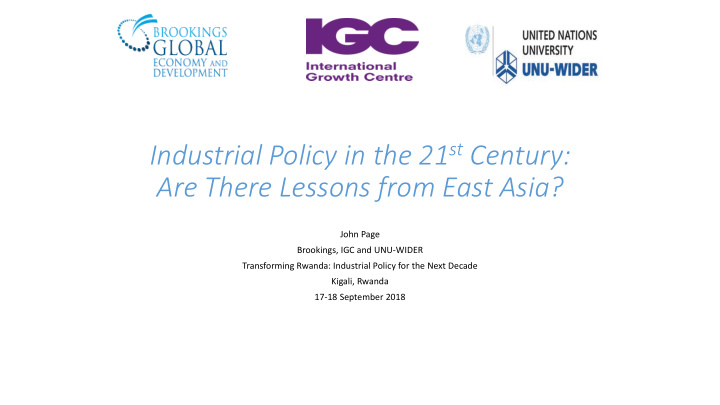



Industrial Policy in the 21 st Century: Are There Lessons from East Asia? John Page Brookings, IGC and UNU-WIDER Transforming Rwanda: Industrial Policy for the Next Decade Kigali, Rwanda 17-18 September 2018
Why Industrial Policy? The Market Place May Not Be Magical • Market imperfections largely define what it means to be underdeveloped • Incomplete or imperfect markets (finance) • Incomplete information (labor markets) • Coordination failures (agglomerations) • Externalities (learning) • Structural change is characterized by many of the market shortcomings listed above . • Industrial policies are designed to stimulate specific economic activities and promote structural change (Lin; Rodrik; Stiglitz)
A Changing Global Economy is Changing Our View of Industry Manufacturing as share of GDP on average declines over four decades • Manufacturing as share of GDP is falling at all levels of per capita income • Technology and falling transport costs have created many new activities that share characteristics of traditional manufacturing… Why? • For example… Horticulture and agro-processing Rising importance of services • “Servicification” of production Tourism • Emergence of GVCs- and trade in tasks • Tradable services, such as Information and communication activities Transit trade and transportation
Structural Change: It’s Not Just Manufacturing Anymore • Patterns of structural change in contemporary low income countries may differ substantially from historical experience. • Global changes and Africa’s resource endowments suggest that many globally competitive activities will be “industries without smokestacks.” • The 21 st Century challenge for policy makers is to promote the growth of high productivity sectors capable of absorbing large numbers of moderately skilled workers, wherever they appear in the economic statistics.
Industrial Policy in the 21 st Century • Because “industries without smokestacks” share many firm characteristics with smokestack industries, they also respond to broadly similar policies • Market imperfections mean that the social returns in growth- promoting investments exceed private returns o A (neo)classic case for public action • Externalities and coordination failures call for a coherent strategy of public action o Put differently, a strategy for structural change • Some elements of East Asia’s industrial transformation can guide such a strategy
Four Drivers of Productivity and Location • The “basics” (AKA: the “Investment Climate”) • Infrastructure and skills • Institutions and regulation • Exports • Firms in low income countries increase their productivity by exporting • Firm capabilities • The tacit knowledge and working practices that affect both productivity and quality • Agglomerations • Industrial clusters confer significant productivity gains • The East Asian experience shows that these four elements are interdependent and mutually reinforcing
New Directions for Industrial Policy: Lessons from East Asia Mounting an “Export Push” • High social returns but high private costs of entry • Entering global markets needs an “East Asian style” export push • Broad ownership and effective institutions (leadership from the top) • Trade related infrastructure and trade logistics • Support for regional institutions and infrastructure in Africa • Sustaining an open trading system and rationalizing preferences
New Directions for Industrial Policy: Lessons from East Asia Building Firm Capabilities • An export push is a major source of capabilities o Demanding buyers; repeated relationships • FDI is another o Build effective FDI agencies • Strengthen domestic value chain relationships • New approaches to management training
New Directions for Industrial Policy: Lessons from East Asia Creating Clusters • Agglomeration economies create a collective action problem • SEZs are a means of creating clusters o Bring Africa’s SEZs up to world class • Strengthen the links between firms in the SEZ and domestic suppliers/purchasers o “Open architecture” in SEZs and better integration with urban planning
The Practice of Industrial Policy • Knowledge about the existence and location of the spillovers, market failures, and constraints that block structural change is diffused widely within society. o To make effective industrial policy governments must engage the private sector • Implementing industrial policy needs “close coordination” with the private sector to identify constraints, shape policies and monitor results • Businesses have strong incentives to “game” the government o This can result in capture.
Coordination through an East Asian Lens • Balancing between engagement and capture is the central challenge of the practice of industrial policy • Coordination mechanisms used by the high performing Asian economies (from Japan to Vietnam) provide some guidance. • Four elements of success: • A high level of commitment of senior government officials to the coordination agenda • Sharply focusing policy decisions and actions on specific constraints to firm performance • A striking willingness to experiment (public policy as pharmacology) • Careful attention to feedback
Accountability is Essential • Good policy requires accepting a certain failure rate o East Asian countries were well known for relying on both incentives and discipline (carrots and sticks) • But who judges success and how do you build the capacity to let the losers go? o East Asia has been less successful in enforcing accountability • Conditionality, sunset clauses, built-in program reviews, monitoring, benchmarking, and periodic evaluation should be features of all incentive programs.
Concluding thoughts • The global economy and changing technology offer new possibilities for structural change. • Industrial policy in the 21 st Century must adapt to these changing opportunities by taking a wider view of industry. • The practice of industrial policy depends fundamentally on engaging the private sector.
Recommend
More recommend